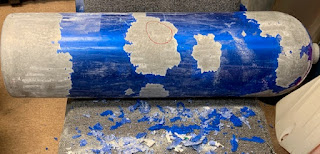The Adventure Continues...to 145'
Fred Stratton
Instructor and Technician
fred@bubblesornot.com
Diving Deep is about Adventure
Decompression stops simply are required safety stops. Both are performed in the same manner: stop and maintain a precise depth for a specific amount of time to clear your computer or to fulfill your analog dive plan based on a chosen decompression algorithm (e.g. RGMB, Buhlman ZHL-16c) and gradient factor.
Deco stops are a means to an end, the end being encounters with deep-dwelling flora and fauna and wrecks resting below recreational diving depth. Tech diving is cool...but that's not a good reason to become a tech diver. Satisfying your craving for adventure and exploration is!
PADI Tec 45
 |
| Clearly mark cylinder contents and maximum operating depth such as OXYGEN MOD 20 Photo: Fred Stratton |
Tec 45 also introduces 100% oxygen (O2) as a dive gas. Pure O2 yields a partial pressure of oxygen (PPO2) of 1.6 atmospheres absolute (ATA) at 20' (6m). Using 100% O2 flushes nitrogen (N2) from your body at an accelerated rate, reducing decompression time.
 |
| Dive Rite's green O2 deco regulator visually reminds diver of breathing gas content Photo: Dive Rite |
We run the risk of central nervous system (CNS) O2 toxicity if our PPO2 rises above 1.6 ATA. Crisply executing deco stops and clearly marking the maximum operating depth (MOD) of our cylinders is absolutely essential. Other smart practices include using green equipment to denote oxygen. Using a green hose and cover on your deco regulator provides visual cues that the gas flowing through that regulator is dangerous to breathe below 20 feet (6 meters). Confidently using pure oxygen to perform accelerated decompression adds a valuable dimension to your diving skill set.
What Can I Dive with Tec 45?
 |
| General Hoyt S. Vandenberg (T-AGM-10) on active duty Photo: US Navy |
The General Hoyt S. Vandenberg rests in 140' (43m) of water. Althought the ship rises to within 50' (15m) of the surface, your Tec 45 training certifies you to see the entire wreck all the way down to the keel. Serving the nation from 1944 to 1984, this magnificent 522-foot long (159m) former missile range instrumentation ship continues duty as an artificial reef seven miles off Key West. It's one example of many alluring wrecks with structure deeper than recreational depth.
 |
| USS ORISKANY (CV-34) underway with her embarked air wing Photo: US Navy |
Named after a Revolutionary War battle, the Essex-class aircraft carrier USS ORISKANY (CV-34) served our great nation for 26 years. Her embarked aircrews flew thousands of combat sorties earning the ship two battle stars for service during the Korean War and five during the Vietnam War before being decommissioned in 1976.
The ORISKANY has attracted divers from around the globe since her sinking in 2006. At 911' (278m) she is the world's largest artificial reef. Her island bristles with interest items for recreational divers.
However, her massive flight deck beckons divers deeper...but it's in 145' (45m) of water. A recreational C-card won't get you there. Your Tec 45 certification will! ORISKANY's flight deck alone takes several dives to explore her 129' (39m) beam and three football field lengths.
What You'll Learn and Do during Tec 45
 |
| Bob Bennett teaches Justin, Dominic and Dan how to rig decompression cylinders for functionality and safety Photo: Tara McNaylor |
Practical Applications
- Working with one's team divers will rig gear to conform with standardized technical rigging philosophy
- Calculate surface air consumption (SAC) rate for bottom and deco times
- Plan a theoretical technical dive with a single gas switch with at least three deco stops using individual diver gas requirements (SAC rate)
- Divers will include turn points, reserves, oxygen toxicity units (OTU) and O2 CNS clock
- Plan a dive using accelerated decompression
Four Open Water Dives
- Dive 1: to a maximum of 30' (9m)
- Dive 2: between 40' (12m) and 60' (18m)
- Dive 3: between 60' (18m) and 100' (30m)
- Dive 4: between 90' (27m) and 145' (9m)
Open Water Skills
- Self & buddy checks: weighting, bubbles and rigging
- Out of gas using long hose as donor and receiver
- Don and remove stage deco cylinder
- Valve shutdown & regulator switch to address freeflowing regulator
- Promary BCD failure, neutral buoyancy with backup system
- Swim at constant depth for 10 minutes to determine SAC rate
- Deploy lift bag or delayed surface marker buoy (DSMB)
- Switching multi-gas computers
- Gas/depth/time awareness - record depth, time & SPG reading each 15 minutes throughout the dive
- Gas switch to O2 at 20' (6m)
- Air break - switch from deco mix to back gas then back to deco mix
- Post-dive review and critique
To Enroll in Tec 45 You Will Have
- Earned Rescue Diver certification
- Earned Tec 40 Diver certification
- Logged at least 50 dives
- 12 dives on EANx deeper than 60' (18m)
- 6 dives on any gas deeper than 100' (30m)
Coming in March
Tec 50: Feeling Alive at 165' (50m)




Comments
Post a Comment